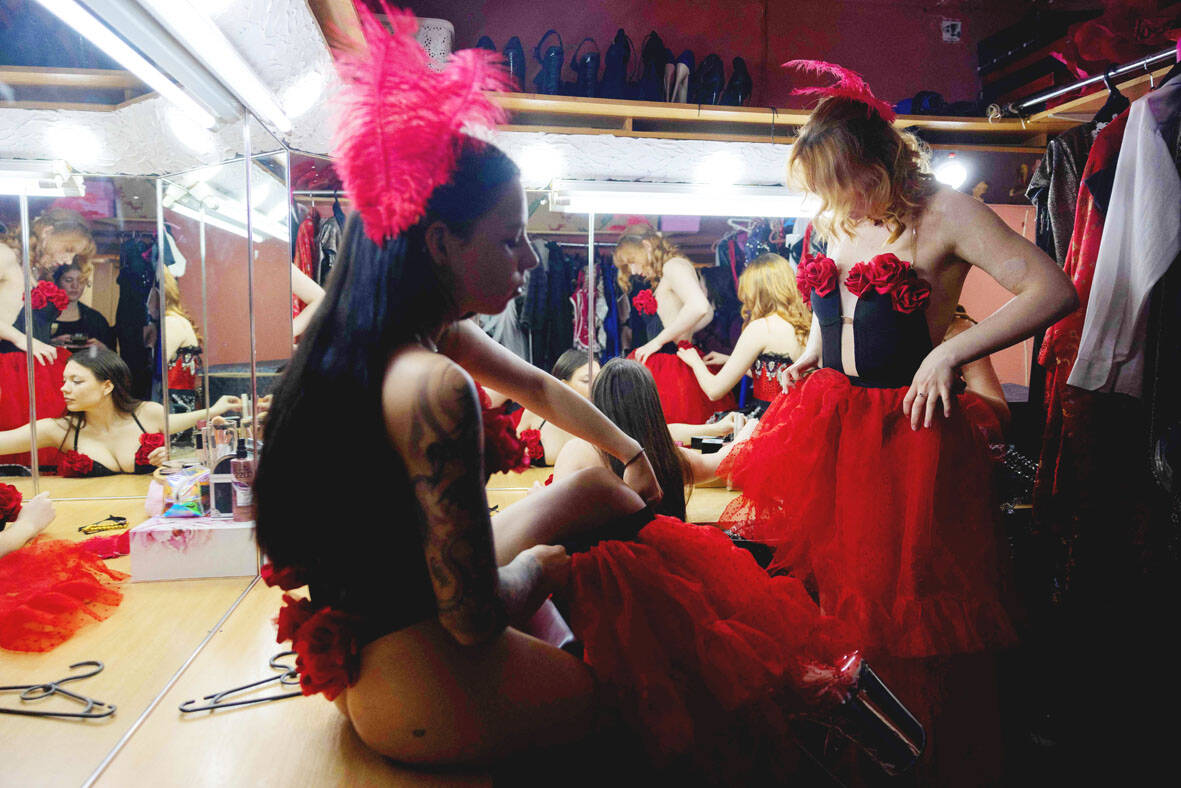When Lisa, 20, laces into her ultra-high heels for her shift at a strip club in Ukraine’s Kharkiv, she knows that aside from dancing, she will have to comfort traumatized soldiers.
Since Russia’s 2022 invasion, exhausted troops are the main clientele of the Flash Dancers club in the center of the northeastern city, just 20 kilometers from Russian forces.
For some customers, it provides an “escape” from the war, said Valerya Zavatska — a 25-year-old law graduate who runs the club with her mother, an ex-dancer.

Photo: AFP
But many are not there just for the show. They “want to talk about what hurts,” she said.
The dancers act as confidantes to soldiers bruised — mentally and physically — by a three-year war with no end in sight.
“Very often” they want to discuss their experiences and feelings, Lisa said in a fitness center, where the dancers practiced choreography to an electro remix of the Carmen opera ahead of that night’s show.
“The problem is that they come in sober, normal, fine. Then they drink, and that’s when the darkness begins,” said Zhenia, a 21-year-old dancer.
Instead of watching the performance, soldiers sometimes sit alone at the bar, crying.
Some even show the women videos from the battlefield — including wounded comrades or the corpses of Russian soldiers.
“It can be very, very difficult, so I personally ask them not to show me, because I take it to heart too much,” Lisa said.
But Zhenia — who used to study veterinary medicine — said she watches the footage with something a professional interest, trying to understand how a soldier could have been saved.
‘FAMILY GATHERING’
When performance time arrived, they put on red underwear, strapped into 20-centimeter (eight inch) platform shoes and covered their bodies with glitter — a trick to stop married men getting too close, as the shiny specks would stick to them.
The music started. One dancer twirled around a pole, another listened attentively to a customer, while a third sat on a man’s lap.
The Flash Dancers describe themselves as more “Moulin Rouge” than a strip club, and say the dancers do not enter sexual relations for money. Prostitution — illegal in Ukraine — is not uncommon in areas near the frontline. Most soldiers — though not all — respect the boundaries.
Sometimes friendships have been struck up.
Zhenia recalled how one soldier wrote a postcard to her, picked out by his mother — a “wonderful woman” who now follows Zhenia on social media and sometimes sends her messages.
“I know their children, their mothers,” she said. Some tell stories from their vacations, talk about their lives before the war and even come back with their wives.
“It’s like a family gathering,” said Nana, a 21-year-old dancer with jet-black hair.
KILLED DANCER
A Colombian soldier fighting for Ukraine sipped sparkling wine on a red bench having paid almost US$10 to get into the club.
Coming here “clears your mind,” said the 37-year-old ex-policeman known as “Puma.”
“It entertains us a little. It takes our minds off the war.” But even in the club’s darkened basement, the war has a way of creeping inside.
Many of the regulars have been wounded and the dancers sometimes take gifts to hospitals. And “an awful lot of guys who have come to us” have been killed, said Zavatska.
“Just this month alone, two died, and that’s just the ones we know,” she said, adding that one left behind a one-year-old infant. A Russian strike in 2022 killed one of the group’s dancers — Lyudmila — as well as her husband, also a former employee of the club.
She was pregnant at the time. Miraculously, her child survived.
The club closes at 10.00pm, an hour before a curfew starts.
Air raid alerts sometimes force them to stay longer, until they can head home in a brief period of relative safety.
But in Kharkiv that never lasts long.
The dancers, like everybody else, are often woken by Russia’s overnight drone and missile barrages.
Even after a sleepless night, the women head back, determined to put on a performance. “The show must go on,” Zavatska said. “We have to smile.”

Dec. 8 to Dec. 14 Chang-Lee Te-ho (張李德和) had her father’s words etched into stone as her personal motto: “Even as a woman, you should master at least one art.” She went on to excel in seven — classical poetry, lyrical poetry, calligraphy, painting, music, chess and embroidery — and was also a respected educator, charity organizer and provincial assemblywoman. Among her many monikers was “Poetry Mother” (詩媽). While her father Lee Chao-yuan’s (李昭元) phrasing reflected the social norms of the 1890s, it was relatively progressive for the time. He personally taught Chang-Lee the Chinese classics until she entered public

Last week writer Wei Lingling (魏玲靈) unloaded a remarkably conventional pro-China column in the Wall Street Journal (“From Bush’s Rebuke to Trump’s Whisper: Navigating a Geopolitical Flashpoint,” Dec 2, 2025). Wei alleged that in a phone call, US President Donald Trump advised Japanese Prime Minister Sanae Takaichi not to provoke the People’s Republic of China (PRC) over Taiwan. Wei’s claim was categorically denied by Japanese government sources. Trump’s call to Takaichi, Wei said, was just like the moment in 2003 when former US president George Bush stood next to former Chinese premier Wen Jia-bao (溫家寶) and criticized former president Chen

Politics throughout most of the world are viewed through a left/right lens. People from outside Taiwan regularly try to understand politics here through that lens, especially those with strong personal identifications with the left or right in their home countries. It is not helpful. It both misleads and distracts. Taiwan’s politics needs to be understood on its own terms. RISE OF THE DEVELOPMENTAL STATE Arguably, both of the main parties originally leaned left-wing. The Chinese Nationalist Party (KMT) brought together radicals, dissidents and revolutionaries devoted to overthrowing their foreign Manchurian Qing overlords to establish a Chinese republic. Their leader, Sun Yat-sen

Late one night in April 2020, towards the start of the COVID lockdowns, Shanley Clemot McLaren was scrolling on her phone when she noticed a Snapchat post by her 16-year-old sister. “She’s basically filming herself from her bed, and she’s like: ‘Guys you shouldn’t be doing this. These fisha accounts are really not OK. Girls, please protect yourselves.’ And I’m like: ‘What is fisha?’ I was 21, but I felt old,” she says. She went into her sister’s bedroom, where her sibling showed her a Snapchat account named “fisha” plus the code of their Paris suburb. Fisha is French slang for